Amazon Brand Analytics: A Deep Dive for Brands
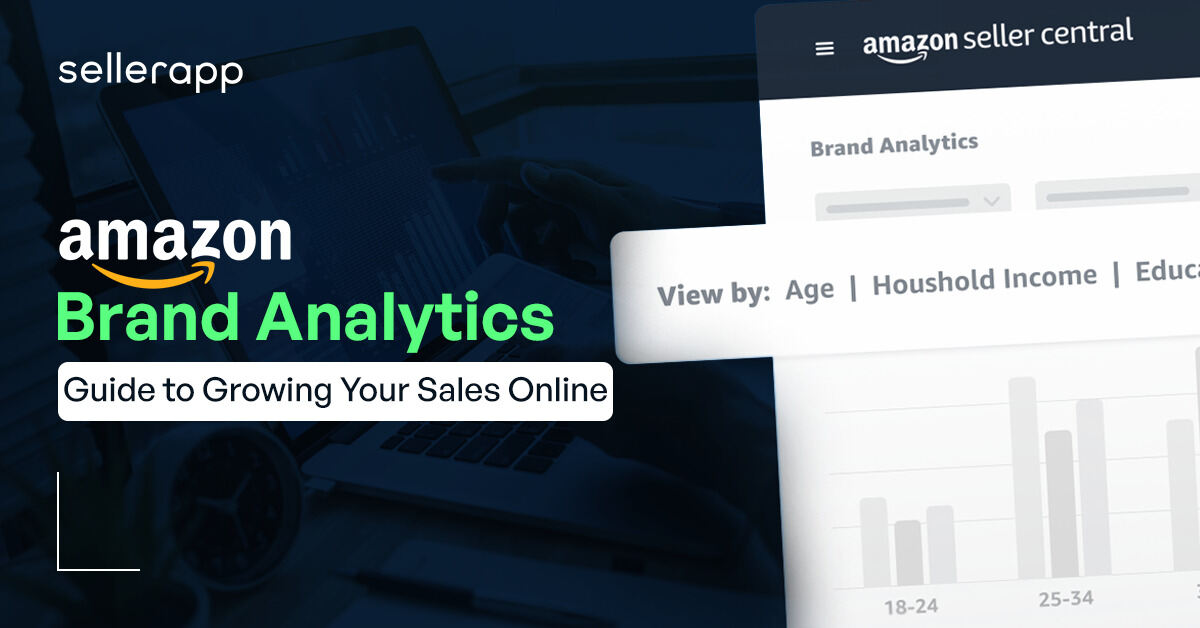
Growing your Amazon business sustainably requires you to build loyalty among your customers.
To do that, it’s important to understand the customers well. Their needs, interests, and purchasing powers – all of these will help you craft a personalized marketing strategy that speaks directly to your customers and gets them to buy your product.
But you need data for that!
Launched in 2019, Amazon Brand Analytics gives you access to all the data you need to understand the purchasing behavior of customers.
Using that, you can effectively craft your marketing strategy and build brand awareness and revenue.
Let’s understand in detail what Amazon Brand Analytics does and how it can help you increase your sales.
A quick peek into the article:
- What is Amazon Brand Analytics?
- Amazon Brand Analytics Eligibility Requirements
- What Reports Can You Get From Amazon Brand Analytics?
- Benefits of Using Amazon Brand Analytics?
- Final Thoughts
What is Amazon Brand Analytics?
Amazon released Amazon Brand Analytics solutions for registered brand owners to help them grow sales and customer loyalty.
This tool gives you an inside view of:
- What keywords do shoppers use to find products,
- The products customers compare and buy after viewing their offers,
- The items customers frequently buy together,
- And the products customers buy repeatedly.
Brand Analytics also provides demographic data on customer location, gender, age, income, and marital status.
With this information, you can:
- Improve product visibility with targeted advertising
- Drive more online sales with smart pricing and attractive offers
- Understand shopping habits to reach new customers
- Offer the right product mix to get ahead of competitors
Not only does Amazon Brand Analytics (ABA) provide these insights, but it also makes them easy to understand and actionable, thanks to its intuitive and user-friendly interface.
Amazon Brand Analytics Eligibility Requirements
Amazon Brand Analytics is available in Seller Central for all Amazon Brand registered sellers.
If you don’t see it in your Seller Central dashboard, you simply don’t meet the criteria to become a brand-registered seller on Amazon.
Learn about how to register your brand on Amazon from this detailed guide.
Where Can You Find The Brand Analytics Tool?
Now, if you are brand-registered, simply log into your Seller Central account and find “Brand Analytics” under the “Brand” section in the left navigation pane.
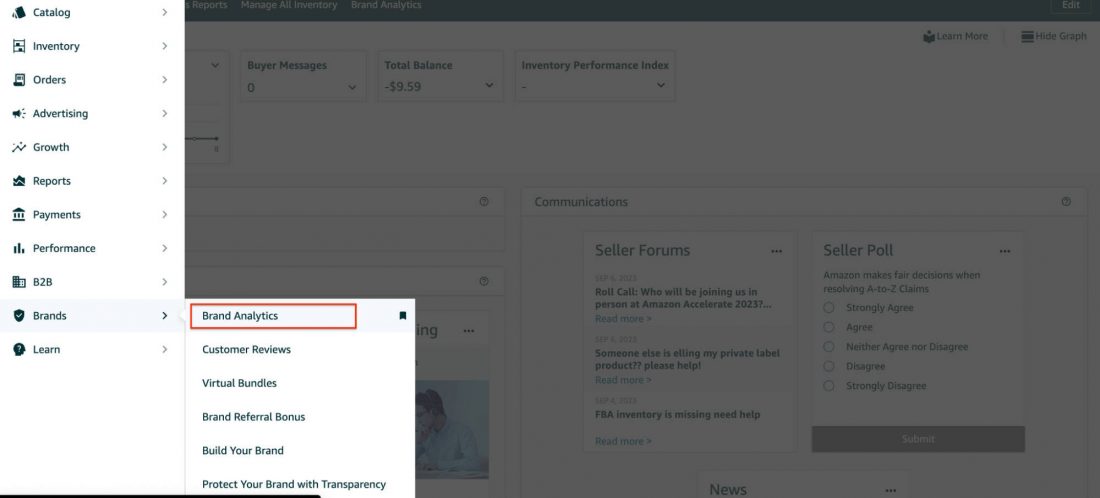
What Reports Can You Get From Amazon Brand Analytics?
In the Brand Analytics Dashboard, you can see six reports in two segments:
- Search Analytics
- Consumer Behavior Analytics
Under search analytics, you get
- Search Catalog Performance
- Search Query Performance
- Top Search Terms
Under consumer behavior analytics,
- Repeat Purchase Behavior
- Demographics
- Market basket Analysis
All these reports help you understand the nitty gritty of the shopping journey, and create a data-driven marketing strategy.
Search Catalog Performance
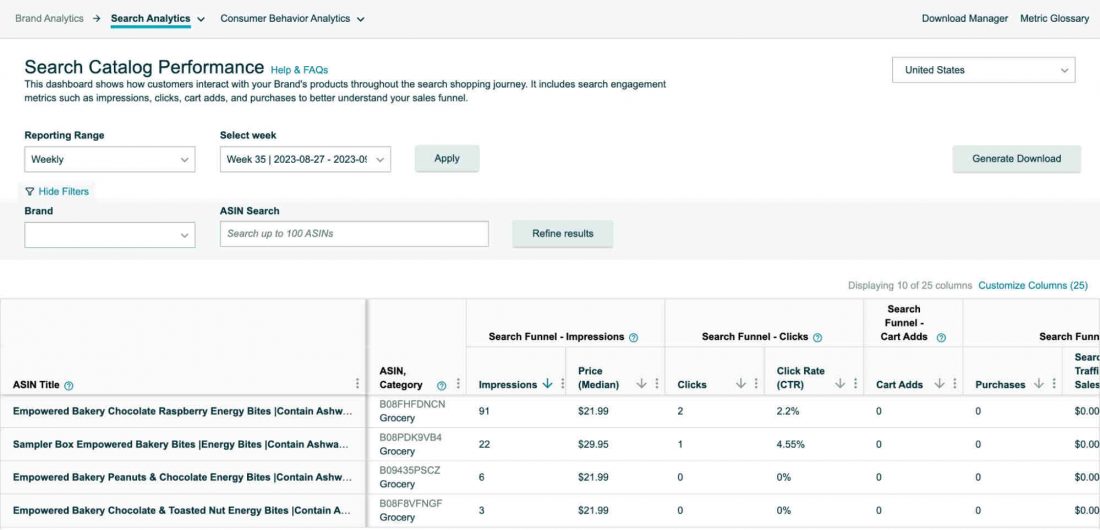
This report reveals how customers interact with your brand’s product throughout the shopping journey.
The Search Catalog Performance Dashboard displays the following metrics for each ASIN:
- Search Funnel – Impressions
- Impressions: Total number of impressions across all search queries during the selected time period
- Rating (Median): Median rating of the ASIN while showing on the search result
- Search Funnel – Clicks
- Clicks: The total number of ASIN clicks or glance views during the selected time period.
- Click Rate (CTR): It represents the percentage of clicks to impressions for ASINs originating from the search results page.
- Search Funnel – Cart Adds
- Cart Adds: The total number of ASINs added to the cart during the selected time period, generated from the search result
- Search Funnel – Purchases
- Purchases: The total number of ASIN purchases during the selected time period, originating from the search results page.
- Search Traffic Sales: The grand total of all sales revenues during the selected time period, originating from the search results page.
- Conversion Rate: It’s the percentage of purchases to clicks for ASINs originating from the search results page.
Apart from these, you also get some other metrics for each stage of the purchasing funnel:
- Same-Day Shipping Speed: Indicates the number of times an ASIN, viewed/ clicked/ placed in the cart/ purchased, displayed a message offering same-day delivery on the search results page.
- 1D Shipping Speed: It records the number of times an “impressed/ clicked/ cart-added/ purchased” ASIN displays a message for “one-day delivery” on the search results page.
- 2D Shipping Speed: Tracks the frequency of an ASIN, viewed/ clicked/ placed in the cart/ purchased, displaying a two-day delivery message on the search results page.
These metrics help you understand how your customers move from one stage to another in their customer journey.
For example, if you see a high number of impressions but a low CTR, it indicates your product listing is not appealing enough, or it may not match customers’ intent. You need to work on the product image and product title to get more clicks.
Similarly, if the cart adds are high but actual purchases are low, it means you have a high cart abandonment rate. Here, you can reduce the friction in the checkout process or implement a retargeting strategy to get people back to your listing and complete the purchase. One of the most essential and effective ways to address this is by sending targeted email campaigns. These can be easily set up and managed with various email marketing platforms, which provide tools to personalize messages and nudge customers to return and finalize their purchase.
With the Shipping Speed (Same day, 1D, 2D) metric, you can determine how it influences the buyer’s decision.
Search Query Performance
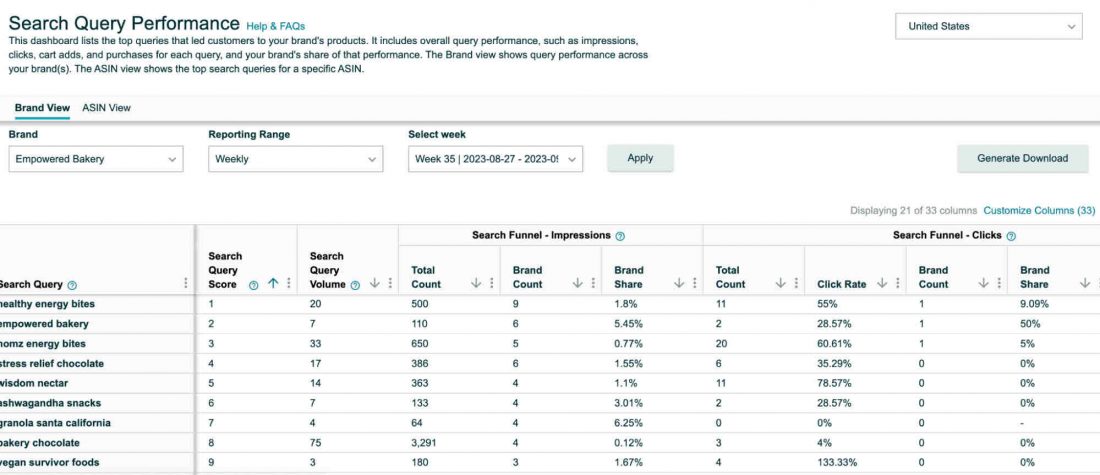
This dashboard displays top search queries that lead to your brand’s products from the search. It also shows overall metrics (impressions, clicks, cart adds, purchases) for each query and your brand’s share.
By default, Amazon shows the Brand view to understand your overall brand(s) performance. But you can also look at the ASIN view to understand the performance of your individual ASIN.
In the Search Query Performance Dashboard, you can find the following metrics for customer queries associated with your brand’s products:
- Search Query Score: The rank of each search query from top to bottom.
- Search Query Volume: The number of times customers search for a specific query on Amazon.
- Impressions: The number of times products appear on the Amazon search page for a query.
In the impressions section, you can find the following metrics:
- Total Count: It shows the number of product impressions for the search query on the Amazon search page.
- Brand Count: It indicates the number of product impressions for your brand on the Amazon search page.
- Brand Share: It is the percentage ratio of Brand Count to the Total Count. It helps you understand where your brand stands compared to the category.
Similar to Brand Count and Brand Share, in the ASIN view report, you get the following metrics:
- ASIN Count: It signifies the number of impressions your ASIN receives on the Amazon search page for the given query.
- ASIN Share: It represents the percentage ratio of ASIN Count to the Total Count for the query.
- Clicks: It indicates the number of times customers click on products in search results.
Similar to impressions, the following metrics are available for clicks:
- Total Count
- Brand Count
- Brand Share
It also provides some additional metrics:
- Click Rate: The percentage ratio of the total number of clicks to the search query volume count within a specific time period. For example, if the search query volume is 10 and customers click on products twice, the Click Rate will be 20%.
- Price (Maiden): The average price of all products related to the query at the time the impression is generated.
- Brand Price (Maiden): The average price of all products belonging to the brand related to the query at the time the impression is generated.
- Same-Day Shipping Speed: This reflects the number of times an ASIN is clicked when same-day shipping options are available for the query.
- 1-Day Shipping Speed: The number of times an ASIN with a “One-Day Shipping” message is clicked for the search query.
- 2-Day Shipping Speed: The number of times an ASIN with a “Two-Day Shipping” message is clicked for the search query.
- Cart Adds: It’s the number of times a product is added to a cart after a search. It includes the following metrics:
- Total Count
- Cart Add Rate
- Brand/ASIN Count
- Brand/ASIN Share
- Price (Median)
- Brand/ASIN Price (Median)
- Same-Day Shipping Speed
- 1D Shipping Speed
- 2D Shipping Speed
- Purchases: It’s the number of times shoppers order a product after using the search query. It includes the following metrics:
- Total Count
- Purchase Rate
- Brand/ASIN Count
- Brand/ASIN Share
- Price (Median)
- Brand/ASIN Price (Median)
- Same-Day Shipping Speed
- 1D Shipping Speed
- 2D Shipping Speed
The Amazon Search Query Performance Dashboard provides valuable insights for brands and sellers throughout the purchasing journey. With this data, sellers can refine their advertising strategy to get more conversions.
Read the complete Search Query Dashboard guide to learn more about it.
Top Search Terms
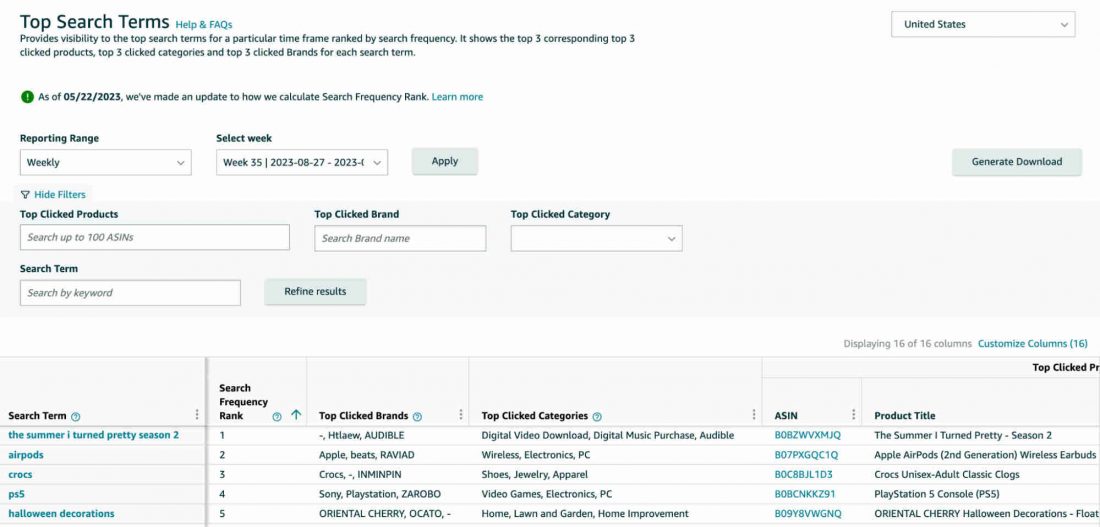
Knowing what customers search for is extremely valuable data for any Amazon brands and advertisers.
Instead of throwing stones in the dark, you can finally see the top search terms in this dashboard. It provides insights into the most frequently searched terms within a selected timeframe.
Search terms are ranked based on their frequency of searches, and for each term, the dashboard shows 3 top-clicked products, categories, and brands.
Here are some key metric definitions to help you navigate and understand the dashboard:
- Search Frequency Rank: Indicates the ranking order of search terms based on their search frequency. Terms with the same frequency will have the same rank.
- Top Clicked Products: Displays the top 3 products that generated the most results for a specific search term. These products are highly relevant to the search query and attract a significant number of clicks.
- Top Clicked Categories: Highlights the top 3 categories that generated the most results for a particular search term. This information helps identify popular categories related to the search term.
- Top Clicked Brands: Identifies the top 3 brands that generated the most results for a specific search term. Knowing which brands attract the most clicks can provide insights into consumer preferences and competitor analysis.
Additionally, the dashboard shows the following metrics for the top three clicked products on the Amazon search page:
- Click Share: It’s the percentage of clicks received by the ASIN compared to the total clicks generated from the search results within the selected timeframe.
- Conversion Share: Indicates the percentage of conversions for an ASIN compared to the total conversions of all ASINs based on the search results within the selected timeframe.
These metrics give sellers valuable insights into popular search terms, products, categories, and more.
Repeat Purchase Behavior Report
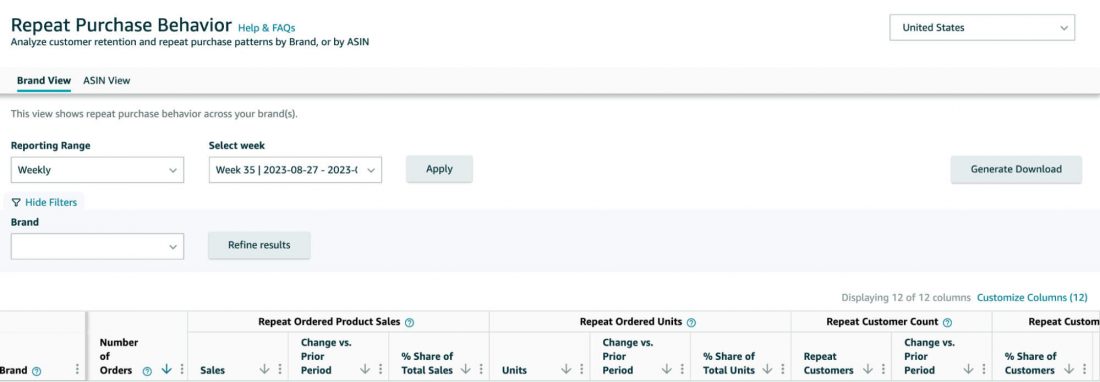
Thousands of people are buying your product, but how many of them are coming back for a repeat purchase?
The Repeat Purchase Behavior Report provides insights into repeat purchase and customer retention patterns by ASIN or brand. It gives you a breakdown of customer purchase behavior and helps you make data-driven decisions to increase brand loyalty.
The metrics found in the Repeat Purchase Behavior Report are
- Total Number of Orders: It gives the total number of orders generated for a brand or ASIN. One order can have multiple product units.
- Repeat Ordered Product Sales:
- Sales: It’s the sales generated from customers who have placed more than one order within the specified reporting time frame.
- Change vs. Prior Period: This is the percentage change in repeat ordered product sales compared to the closest previous period to the selected time range.
- % Share of Total Sales: It showcases the percentage of repeat ordered product sales in relation to the total ordered product sales.
- Repeat Ordered Units
- Units: It’s the number of product units purchased by customers who made more than one order within the selected reporting time range.
- Change vs. Prior Period: The percentage change in repeat ordered units compared to the closest previous period before the selected reporting time range.
- % Share of Total Sales: The percentage of repeat ordered units out of the total unit sales.
- Repeat Customer Count
- Repeat Customers: It’s the total number of distinct customers who placed multiple orders within the specified reporting time period.
- Change from Previous Period: It’s the percentage change in repeat customers from the most recent period before the selected reporting time period.
- Repeat Customer Share
- Customer Share: It’s the percentage of repeat customers from the total number of customers who made an order within the selected time period.
- Change from Previous Period: It’s the percentage change for repeat customers compared to the most recent period prior to the selected reporting time period.
Demographic Report
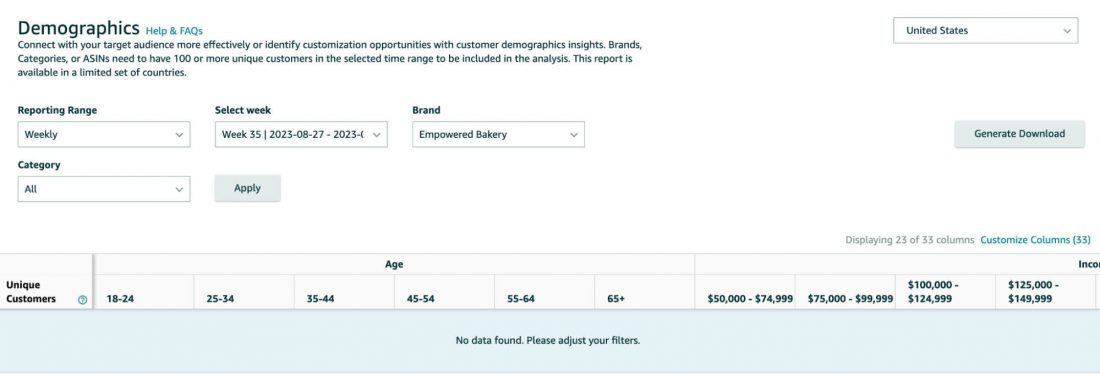
Do you know who are your target customers? Do you know how old are they? How much do they earn?
In the demographic report, you can get insights into all these, including their age, household income, education, gender, and marital status.
It helps you understand your target audience on a granular level. You can use this information to optimize your on and off-Amazon marketing messaging to maximize awareness and conversions.
Market Basket Analysis
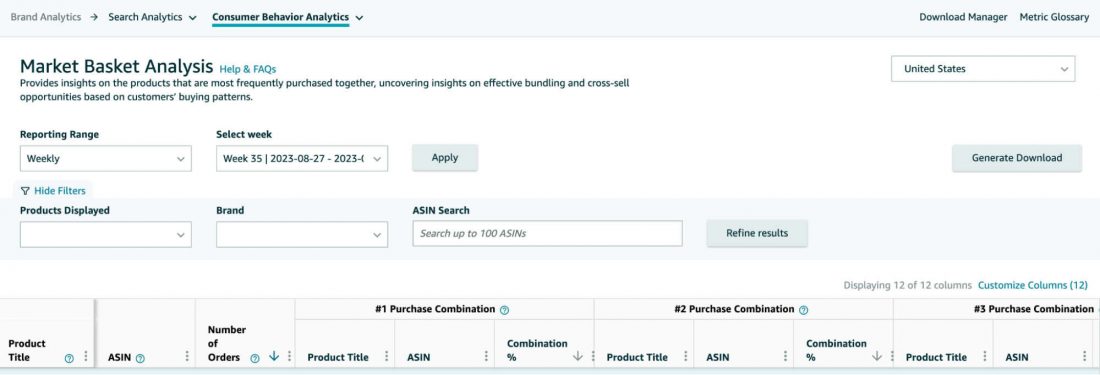
You can see customers are visiting your product and purchasing. But is there any way to increase the average order value?
For example, customers are buying yoga mats. They also tend to purchase sweatpants and sports shoes. Since you don’t offer them, customers naturally shift towards some other brands.
Instead, if you bundle a yoga mat with sweatpants and shoes, it can increase the average order value.
But how do you know what products shoppers commonly buy together?
Market Basket Analysis provides insights into the products that are frequently purchased together, allowing you to create effective bundling and cross-selling opportunities.
The report gives the following metrics for the top three purchase combinations:
- Product Title
- Product ASIN
- Combination %
The Market Basket Report helps you identify cross-marketing opportunities and create value-based bundles to increase the average order value.
Benefits of Amazon Brand Analytics
The Amazon Brand Analytics tool comes with multiple benefits. Here are some of them:
Get First-hand Marketplace Data
Amazon Brand Analytics provides accurate market data straight from Amazon’s in-house reporting. This includes customer behaviors, search trends, and buying habits on the platform.
You can use this data to create data-backed marketing strategies.
ABA tool also provides market-wide reporting without restricting itself to a single brand. It gives brands a birds-eye view of the broader market, allowing them to identify trends and opportunities for growth.
Identify Target Audience
With the Demographic report, you can tap into your target audience with utmost accuracy.
Let’s assume that you are selling organic moisturizers. When you went through the Demographic data, you saw that most of your audience who are purchasing the product are between 18 – 24 women, earning $50,000 – $74,999, and unmarried.
With this information, you can create personalized ad copy directed to your target audience that generates better results.
Understand Customer Shopping Behavior
With the Repeat purchase analysis dashboard, you can understand which ASINs and brands get the most repeat purchases. This information helps you optimize your advertising strategy to get more sales for these products.
Identify High-Performing Keywords
You can also find search terms that perform well from Amazon Brand Analytics.
For example, if you see on the Search Query Performance report that some keywords have high search volume and also have significant cart-add and purchase count, it means it’s a high-performing search query.
You can increase your advertising budget for this keyword to increase conversion chances.
Even though ABA is a sophisticated tool, it doesn’t give all the information about a search query.
You should pick search terms with decent search volume and are moderately competitive, and you want to find better insights into keywords. Here’s what you can do:
- Step 1: Navigate to SellerApp Keyword Research tool.
- Step 2: Type the search term you want to search and analyze.
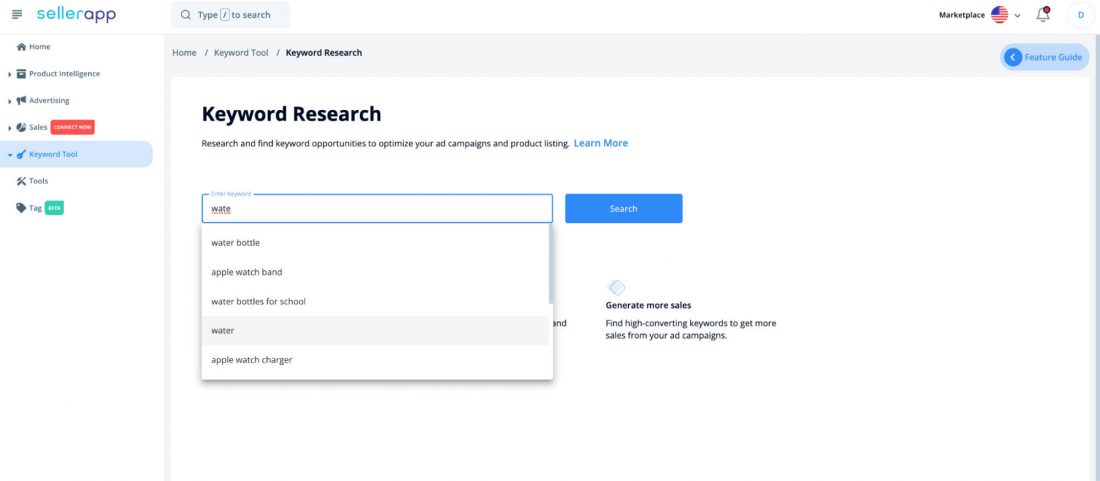
- Step 3: Analyze the result based on search volume, relevancy score, estimated orders, and conversion rate to find the most profitable keywords.
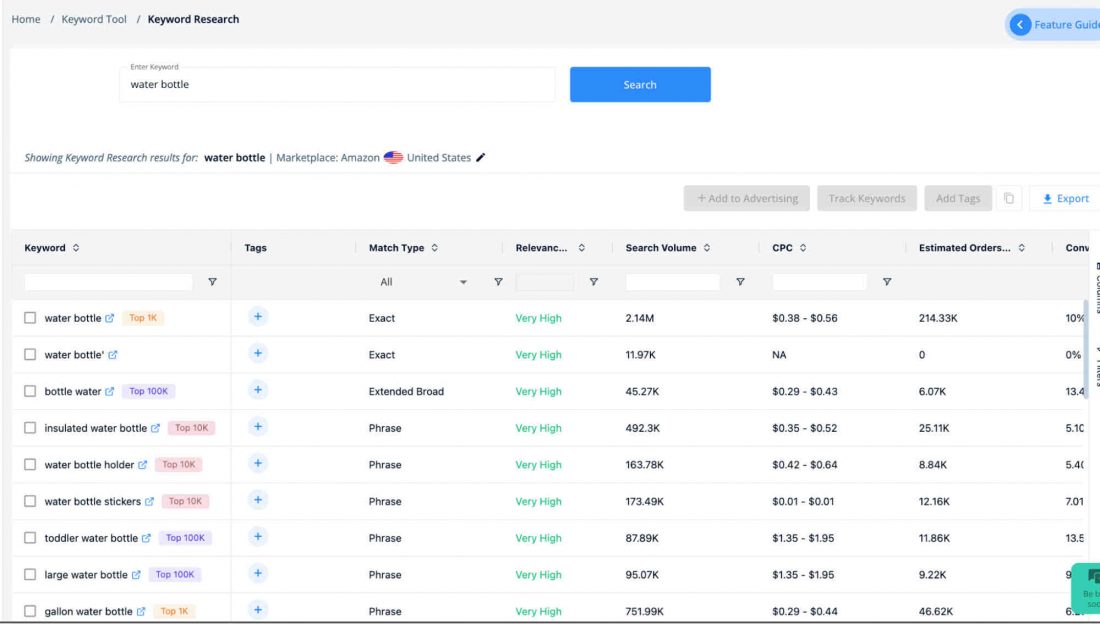
Final Thoughts
Scaling an e-commerce business can be tricky, and Amazon is no exception.
With the data from Amazon Brand Analytics, you can optimize your business on a deeper level and increase the chances of sales.
However, Amazon Brand Analytics does not provide you with everything. You still need a seller tool like SellerApp to get additional insights on keywords, conduct competitor analysis, optimize your listing, and automate your advertising campaigns.
On top of that, you need experts who can help you create and optimize your PPC campaigns to maximize your ROAS. We’ve already helped 20,000+ brands, including Philips and Coca-Cola, create full-funnel advertising strategies.
And we can do the same for you.
Schedule a call with us and kickstart your e-commerce growth now!
Additional read: Tips To Create An Amazing Amazon Brand Story (With Examples)











Valech
May 1, 2019Appreciate you guys
Bajensen
May 2, 2019Thank you SellerApp for helping Amazon brand owners
Wonderful information
Israel Nickerson
February 25, 2021Very Informative article. Thanks again
Perfectly explained each and every step of Amazon Brand Analytics
Thank you SellerApp.
Arishekar N
June 29, 2021We are happy to hear that you liked the blog.
Thank you.